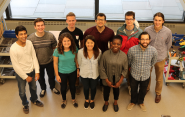From Sound Cancellation to Insole Sensors, the 2017 CEID Fellows Are Ready to Innovate

The fifth cohort of the Yale School of Engineering & Applied Science's Summer Design Fellowship program arrived this week at the Center for Engineering Innovation and Design (CEID) to begin their eight-week session. Commence the innovations!
 The 10 students in residence at the CEID comprise four teams of two to four members, each working on a specific project. Rather than working on previously established research projects, students in the Yale CEID Summer Design Fellowship have access to resources that allow them to develop hardware and software solutions for a specific problem. It is the only fellowship specifically designed to assist "makers" at Yale.
The 10 students in residence at the CEID comprise four teams of two to four members, each working on a specific project. Rather than working on previously established research projects, students in the Yale CEID Summer Design Fellowship have access to resources that allow them to develop hardware and software solutions for a specific problem. It is the only fellowship specifically designed to assist "makers" at Yale.
As usual, this year’s batch of projects area cover a wide range. In past years, CEID fellows have published papers, started companies, and worked on everything from backyard ice rinks to medical devices.
Here are the this year’s four projects – we’ll keep you updated as they progress over the summer:
Happy Feet – This team, comprising Lauren Chapey ‘20, Joyce Duan ’20, and Ethan O’Reilly ‘20, will develop a sensor to be placed in the insole of the shoes of people at high risk of diabetes. The sensor would detect any abnormalities in the user’s gait, which can be a sign of low insulin and lead to serious problems if not treated.
Variant Vision – With this project, Oyindamola Alliyu ’20 and Antonio Medina ’19 seek to update the cane for the visually impaired. Combining the traditional cane with a Braille pad, they envision a device that give users direct and specific information about their surroundings and approaching objects.
Quiet Breeze – Manuel Schneider ‘20, Kiran Chokshi and Sebastian Rivero ’19, plan to develop technology that would allow fresh air into your living quarters while keeping the outside sounds outside. Their sound cancellation device will feature Helmholtz resonators and soundwave diffraction. They’ve got it working at 10 decibels already; their goal is 35db.
Exoskeleton for the Arm - Acshi Haggenmiller and Tim Foldy-Porto ’20 are developing an exoskeleton device to be worn over the arm. Their goal is a device that provides an additional 100 pounds of strength to the lifter. Potential users include those in the shipping industry and health care workers.

